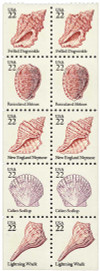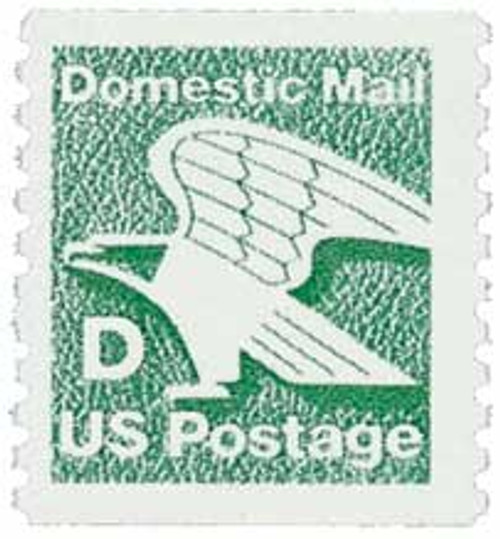
# 2117-21 - 1985 22c Seashells
U.S. #2117-21
1985 22¢ Seashells
- First US postal item to feature seashells
- First intaglio web-fed stamps printed with blending technique
Stamp Category: Definitive
Set: Seashells
Value: 22¢, rate for first-class mail
First Day of Issue: April 4, 1985
First Day City: Boston, Massachusetts
Quantity Issued: 4,130,040,000
Printed by: Bureau of Engraving and Printing
Printing Method: Engraved
Format: Booklet Panes of 5 from Printing Plates of 960
Perforations: 10 Horizontal
Why the stamps were issued: To replace the “D” rate change stamps issued earlier in 1985.
About the stamp designs: These stamps had been in the works for four years. They were initially planned for a 1984 release, but the USPS pushed them to 1985 so they could be issued at the new 22¢ first-class rate. Peter Cocci designed the stamps, using color photos of the country’s largest seashell collection from the National Museum in Washington, DC.
The stamps depict two different types of mollusks. Univalves are the largest of the mollusk class and are single shells. Bivalves are the next largest class and are actually two shells hinged together. The five shells pictured on these stamps are all found in North American waters. These stamps picture:
The Frilled Dogwinkle (Nucella lamellose) is found from Alaska to California. The stamp was printed in black and brown.
The Reticulated Helmet (Cypraecassis testiculus) is found from Texas to Brazil. The stamp was printed in black, brown, and purple.
The New England Neptune (Neptunea decemcostata) is found from Canada to Massachusetts. The stamp was printed in black and brown.
The Calico Scallop (Argopecten gibbus) is found from the Carolinas to Texas. The stamp was printed in black and purple.
The Lighting Whelk (Busycon contrarium) is found from the Carolinas to Texas. The stamp was printed in black, brown, and purple.
About the printing process: The Bureau of Engraving and Printing (BEP) used “blend printing” on the Lightning Whelk and Reticulated Helmet stamps. Normally, the ink colors don’t overlap. But for these stamps, the colors did overlap, to create more varied hues. While the BEP had used this technique before on a sheet-fed press, these stamps were the first produced in such a manner on the web-fed intaglio C Press.
The BEP wanted to make better, more creative use of their equipment and craftsmen, and experimented with the booklet cover for the Seashell stamps. They produced their first-ever “floating” design. BEP artist Frank Waslick painted a strip of 25 different shells that was repeated across multiple covers. Initially, the USPS packaged seven booklets together, that would allow people to see the complete painting. However, this proved costly and they eventually created a more standard design that could be printed cheaper and more efficiently.
First Day City: The First Day ceremony for these stamps was held at Harvard University, in Cambridge, Massachusetts. That day also marked the 75th anniversary of the Boston Malacological Club, which is the second oldest seashell club in the US.
Unusual fact about these stamps: Error stamps have been discovered in which the colors were misaligned and the denomination appeared to be 2¢. There have also been stamps found without tagging and imperforate.
History the stamps represent: People have been collecting and studying seashells for thousands of years – one collection was even found buried in Pompeii. Today, seashells are one of the most popular items to collect in the world – second only to postage stamps.
Aristotle and Pliny the Elder were two of the first scholars to study and write about seashells. Aristotle discovered the nature of the creatures inside the objects and was the first to call them mollusca (soft-bodied). Pliny the Elder found out even more and included his findings in his book, Historia Naturalis.
The hobby of conchology grew and seashells became popular outside of it, too. One of the best places to view impressive seashell collections is the Bailey Matthews National Shell Museum on Sanibel Island, Florida. Some of its exhibits were donated by conchologists from around the world, while others come right from Sanibel Island. The museum was founded in 1990 by brothers John, Francis, and Sam Bailey.
Collected for their beauty and rarity, shells were once used as tools and currency. American Indians used shells, called wampum, for money. The more colorful the shell, the more valuable the wampum. Polished shells were also used for ornamental beadwork on their clothing.
Seashells have been used in sculptures, decorations, as a replacement for gravel, and more. Countries around the world have even featured seashells on their postage stamps. Some 5,000 stamps recognize the devotion of hobbyists from all countries, and their continued work toward discovering the secrets of the sea.
U.S. #2117-21
1985 22¢ Seashells
- First US postal item to feature seashells
- First intaglio web-fed stamps printed with blending technique
Stamp Category: Definitive
Set: Seashells
Value: 22¢, rate for first-class mail
First Day of Issue: April 4, 1985
First Day City: Boston, Massachusetts
Quantity Issued: 4,130,040,000
Printed by: Bureau of Engraving and Printing
Printing Method: Engraved
Format: Booklet Panes of 5 from Printing Plates of 960
Perforations: 10 Horizontal
Why the stamps were issued: To replace the “D” rate change stamps issued earlier in 1985.
About the stamp designs: These stamps had been in the works for four years. They were initially planned for a 1984 release, but the USPS pushed them to 1985 so they could be issued at the new 22¢ first-class rate. Peter Cocci designed the stamps, using color photos of the country’s largest seashell collection from the National Museum in Washington, DC.
The stamps depict two different types of mollusks. Univalves are the largest of the mollusk class and are single shells. Bivalves are the next largest class and are actually two shells hinged together. The five shells pictured on these stamps are all found in North American waters. These stamps picture:
The Frilled Dogwinkle (Nucella lamellose) is found from Alaska to California. The stamp was printed in black and brown.
The Reticulated Helmet (Cypraecassis testiculus) is found from Texas to Brazil. The stamp was printed in black, brown, and purple.
The New England Neptune (Neptunea decemcostata) is found from Canada to Massachusetts. The stamp was printed in black and brown.
The Calico Scallop (Argopecten gibbus) is found from the Carolinas to Texas. The stamp was printed in black and purple.
The Lighting Whelk (Busycon contrarium) is found from the Carolinas to Texas. The stamp was printed in black, brown, and purple.
About the printing process: The Bureau of Engraving and Printing (BEP) used “blend printing” on the Lightning Whelk and Reticulated Helmet stamps. Normally, the ink colors don’t overlap. But for these stamps, the colors did overlap, to create more varied hues. While the BEP had used this technique before on a sheet-fed press, these stamps were the first produced in such a manner on the web-fed intaglio C Press.
The BEP wanted to make better, more creative use of their equipment and craftsmen, and experimented with the booklet cover for the Seashell stamps. They produced their first-ever “floating” design. BEP artist Frank Waslick painted a strip of 25 different shells that was repeated across multiple covers. Initially, the USPS packaged seven booklets together, that would allow people to see the complete painting. However, this proved costly and they eventually created a more standard design that could be printed cheaper and more efficiently.
First Day City: The First Day ceremony for these stamps was held at Harvard University, in Cambridge, Massachusetts. That day also marked the 75th anniversary of the Boston Malacological Club, which is the second oldest seashell club in the US.
Unusual fact about these stamps: Error stamps have been discovered in which the colors were misaligned and the denomination appeared to be 2¢. There have also been stamps found without tagging and imperforate.
History the stamps represent: People have been collecting and studying seashells for thousands of years – one collection was even found buried in Pompeii. Today, seashells are one of the most popular items to collect in the world – second only to postage stamps.
Aristotle and Pliny the Elder were two of the first scholars to study and write about seashells. Aristotle discovered the nature of the creatures inside the objects and was the first to call them mollusca (soft-bodied). Pliny the Elder found out even more and included his findings in his book, Historia Naturalis.
The hobby of conchology grew and seashells became popular outside of it, too. One of the best places to view impressive seashell collections is the Bailey Matthews National Shell Museum on Sanibel Island, Florida. Some of its exhibits were donated by conchologists from around the world, while others come right from Sanibel Island. The museum was founded in 1990 by brothers John, Francis, and Sam Bailey.
Collected for their beauty and rarity, shells were once used as tools and currency. American Indians used shells, called wampum, for money. The more colorful the shell, the more valuable the wampum. Polished shells were also used for ornamental beadwork on their clothing.
Seashells have been used in sculptures, decorations, as a replacement for gravel, and more. Countries around the world have even featured seashells on their postage stamps. Some 5,000 stamps recognize the devotion of hobbyists from all countries, and their continued work toward discovering the secrets of the sea.
















